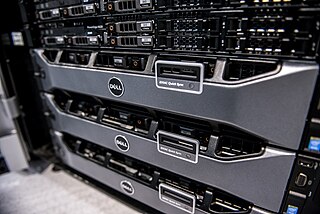Traffic shaping is a bandwidth management technique used on computer networks which delays some or all datagrams to bring them into compliance with a desired traffic profile. Traffic shaping is used to optimize or guarantee performance, improve latency, or increase usable bandwidth for some kinds of packets by delaying other kinds. It is often confused with traffic policing, the distinct but related practice of packet dropping and packet marking.

Juniper Networks, Inc. is an American multinational corporation headquartered in Sunnyvale, California. The company develops and markets networking products, including routers, switches, network management software, network security products, and software-defined networking technology.
Fortinet is an American multinational corporation headquartered in Sunnyvale, California. The company develops and sells cybersecurity solutions, such as physical firewalls, antivirus software, intrusion prevention systems, and endpoint security components.

Check Point is an American-Israeli multinational provider of software and combined hardware and software products for IT security, including network security, endpoint security, cloud security, mobile security, data security and security management.

The PowerEdge (PE) line is Dell's server computer product line.
WAN optimization is a collection of techniques for improving data transfer across wide area networks (WANs). In 2008, the WAN optimization market was estimated to be $1 billion, and was to grow to $4.4 billion by 2014 according to Gartner, a technology research firm. In 2015 Gartner estimated the WAN optimization market to be a $1.1 billion market.
Packeteer, Inc., founded in 1996 by Robert Packer and Brett Galloway, was an I.T. company based in Cupertino, California that was listed on the NASDAQ. Networking appliances focus on Application Traffic Management and optimization for wide area networks. They held at least 40 patents for various network optimization methods. Packeteer was acquired by Blue Coat Systems in 2008.
Riverbed Technology is an American information technology company. Its products consist of software and hardware focused on Unified Observability, Network Visibility, End User Experience Management, network performance monitoring, application performance management, and wide area networks (WANs), including SD-WAN and WAN optimization.

Hitachi Data Systems (HDS) was a provider of modular mid-range and high-end computer data storage systems, software and services. Its operations are now a part of Hitachi Vantara.
ApplianSys, founded in 2000, is a privately held venture capital-backed technology company based in Coventry, United Kingdom. It designs, builds and markets Internet server appliances that are deployed in more than 150 countries. Forrester Research have listed ApplianSys as being a key vendor in the worldwide IP Address Management market, with its DNS engine used in a third of all GPRS networks.

Blue Coat Systems was a company that provided hardware, software, and services designed for cybersecurity and network management. In 2016, it was acquired by and folded into Symantec.
Silver Peak is a company that develops products for wide area networks (WANs), including WAN optimization and SD-WAN. The company was founded in 2004 by David Hughes. Silver Peak shipped its first product, the NX-series hardware appliance, in September 2005, and their first SD-WAN solution, EdgeConnect, in June 2015.
Hewlett Packard Enterprise and its predecessor entities have a long history of developing and selling networking products. Today it offers campus and small business networking products through its wholly owned company Aruba Networks which was acquired in 2015. Prior to this, HP Networking was the entity within HP offering networking products.
Infineta Systems was a company that made WAN optimization products for high performance, latency-sensitive network applications. The company advertised that it allowed application data rate to exceed the nominal data rate of the link. Infineta Systems ceased operations by February 2013, a liquidator was appointed, and its products will no longer be manufactured, sold or distributed. Riverbed Technology purchased some of Infineta's assets from the liquidator.
Skyfire is a software company founded in 2007, and acquired by Opera Software ASA, now Otello Corporation, in 2013. In 2015, the company became the Network Solutions division of Opera, and ceased using the Skyfire brand name. They offer network optimization technologies including video optimization and monetization tools for carriers. Skyfire discontinued its Skyfire Web Browser in 2014 in order to consolidate its focus on its mobile operator technology. Skyfire was funded by venture capital, and was acquired by Opera Software ASA in March 2013.

Teradici Corporation was a privately held software company founded in 2004, which was acquired by HP Inc. in October 2021. Teradici initially developed a protocol (PCoIP) for compressing and decompressing images and sound when remotely accessing blade servers, and implemented it in hardware. This technology was later expanded to thin clients/zero clients for general Virtual Desktop Infrastructure. Teradici's protocol or hardware is used by HP, Dell-Wyse, Amulet Hotkey, Samsung, Amazon Web Services, Fujitsu, and VMware.
Array Networks is an American networking hardware company. It sells network traffic encryption tools.
A software-defined wide area network (SD-WAN) is a wide area network that uses software-defined network technology, such as communicating over the Internet using overlay tunnels which are encrypted when destined for internal organization locations.
NetScaler is a line of networking products owned by Cloud Software Group. The products consist of NetScaler, an application delivery controller (ADC), NetScaler AppFirewall, an application firewall, NetScaler Unified Gateway, NetScaler Management & Analytics System, and NetScaler SD-WAN, which provides software-defined wide-area networking management. NetScaler was initially developed in 1997 by Michel K Susai and acquired by Citrix in 2005. Citrix consolidated all of its networking products under the NetScaler brand in 2016.
A secure access service edge (SASE) is technology used to deliver wide area network (WAN) and security controls as a cloud computing service directly to the source of connection rather than a data center. It uses cloud and edge computing technologies to reduce the latency that results from backhauling all WAN traffic over long distances to one or a few corporate data centers, due to the increased movement off-premises of dispersed users and their applications. This also helps organizations support dispersed users and their devices with digital transformation and application modernization initiatives.





